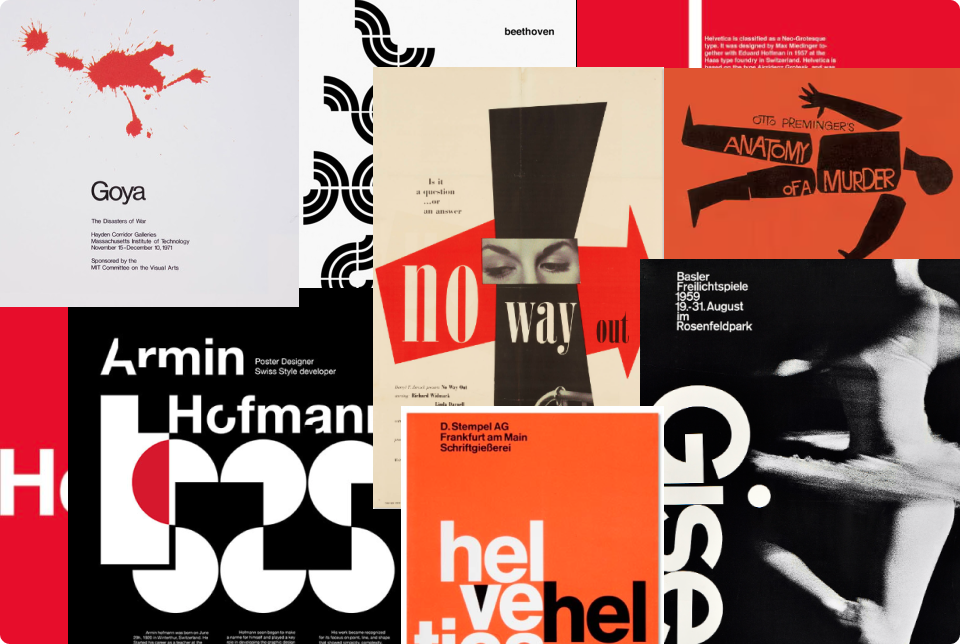
Emiliya Georgieva
20 Mar
11 mins read
- Copy link
Designers Who Inspire: A Journey Through Aesthetics and Function

The world of graphic design is rich with pioneering artists whose work continues to inspire generations of creatives. The legacy of these designers is not merely in the beauty of their creations but also in their relentless pursuit of simplicity, utility, and innovation. Today, let's celebrate some of these trailblazers and their influential work.
The Swiss Influence: Clarity, Simplicity, and Objectivity
The Swiss Style, also known as International Typographic Style, has significantly influenced the direction of graphic design. This style is known for its clear and legible designs that emphasize cleanliness and readability.
Armin Hofmann
Armin Hofmann's philosophy of design was deeply rooted in the Swiss Style. His work is characterized by minimalistic designs that communicate with precision. Hofmann's posters, notably the one for 'Giselle', exemplify the marriage of typography, geometry, and contrast, demonstrating his mastery in visual communication.
Max Miedinger
Typeface design is another realm where Swiss designers have left an indelible mark. Max Miedinger, in collaboration with Eduard Hoffmann, created the now-ubiquitous Helvetica typeface. Designed in 1957, Helvetica is celebrated for its neutrality and has been widely used for its versatility and readability.
Josef Müller-Brockmann
A proponent of the grid system, Josef Müller-Brockmann is renowned for his work in posters and magazine designs. His designs often feature a mathematical grid, ensuring structure and coherence, as can be seen in his poster for 'Beethoven'. His methodical approach to design ensures that each element is there for a reason, promoting a sense of purposeful clarity.
The Typography Revolutionaries: Emphasis on Expression
Typography has been a powerful tool for designers to express, influence, and even provoke.
Helmut Schmid
Helmut Schmid's typography work often broke the conventional rules, bringing about a dynamic and expressive approach to lettering. His work is an exploration of how type can go beyond mere reading to become a visual experience.
Graphic Narratives: Telling Stories Through Design
Some designers have excelled in creating visual narratives that are both engaging and instructive.
Paul Rand
The American graphic designer Paul Rand is known for his corporate logo designs, but his poster work reveals a playful and imaginative side. His use of color, shape, and form created engaging compositions that are still studied and admired.
The Cultural Visualizers: Bridging Art and Audience
The role of graphic designers in shaping cultural understanding cannot be understated. They often stand at the crossroads of art and its audience, making it accessible and appreciated.
Saul Bass
Saul Bass has been a pivotal figure in the world of design, especially in film. His title sequences and posters have not only complemented the stories they represent but have also become iconic in their own right. Bass's designs are characterized by their bold and symbolic imagery.
Conclusion
The designers we admire today were innovators in their time. They didn't just create visually appealing work; they challenged the norms, pushed boundaries, and in doing so, defined the principles that continue to guide designers today. As we reflect on these masters, we find inspiration for our own work, reminding us that great design is not just about what is seen—it's about the message that is communicated and the experience it engenders. Whether through the precise clarity of the Swiss Style or the expressive power of typography, these artists have shaped a world where design is an essential language of our everyday life.
As we create, let's carry forward the spirit of innovation, clarity, and purpose that these pioneers championed. For it's in this spirit that design moves from good to great, from function to art.